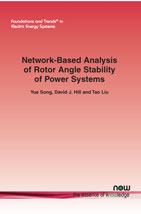Network-Based Analysis of Rotor Angle Stability of Power Systems
By Yue Song, The University of Hong Kong, Hong Kong, yuesong@eee.hku.hk | David J. Hill, The University of Hong Kong, Hong Kong | Tao Liu, The University of Hong Kong, Hong Kong
Abstract
Rotor angle stability refers to the ability of synchronous machines in a power system to remain in synchronism after a disturbance. It is one of the basic requirements for secure operation of electric power systems. Traditional analysis methods for rotor angle stability are oriented to node dynamics, especially the impact of generator modeling and parameters, while power network parameters are simply treated as some coefficients in the system dynamical models. Thanks to the progress on graph theory and network science, there is an emerging trend of investigating the connections between power network structures and system dynamic behaviors. This monograph surveys the network-based results on rotor angle stability in both early and recent years, where the role of power network structure is elaborated. It reveals that rotor angle dynamics essentially link to some graph quantities (e.g., Laplacian matrix, cutset, effective resistance) defined over the underlying power network structure. New theories for angle stability are developed using advanced graph theory tools tailored for power networks. These results provide novel solutions to some important problems that have not been well addressed in the traditional node-based studies, such as the impact of those lines with large angle differences on stability, cutset vulnerability assessment and convexification of stability constrained optimal power flow. The purpose of this monograph is to establish a networkbased paradigm that sheds new light on the mechanism of angle stability under small and large disturbances.
Network-Based Analysis of Rotor Angle Stability of Power Systems
Rotor angle stability is a topic of fundamental importance in electric power systems. Traditionally, rotor angle stability analysis is oriented to node dynamics, especially the impact of generator modeling and parameters. On the other hand, the power network structural information is simply treated as some coefficients in the system dynamical models, which have been paid less attention.
This monograph surveys the network-based theories of rotor angle stability that elaborate the role of power network structure, including the results developed in early years as well as in recent years that are facilitated by the new progress on graph theory. It focuses on the connections between power network structures and system dynamic behaviors, and those graph theoretic tools tailored for power system analysis.
This publication provides new insights into some important problems in rotor angle stability that have not been well addressed by the traditional node-based approaches. Network-Based Analysis of Rotor Angle Stability of Power Systems is a must-read for all students and researchers working on the cutting edge of electric power systems.
